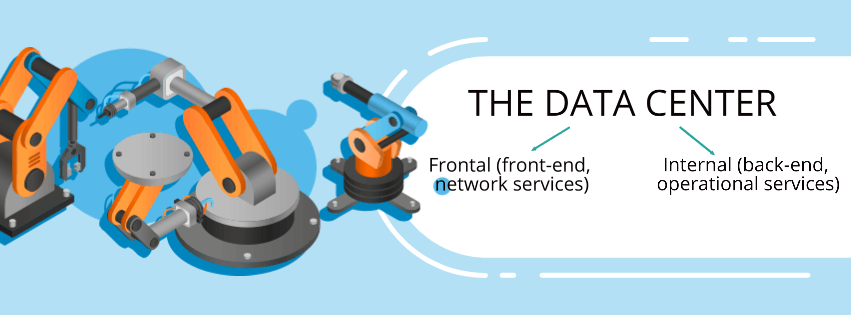Data processing center (DPC) is a complex of engineering and IT systems to provide a single integrated enterprise information resource with guaranteed levels of reliability, availability, and data security. The core of the data center is an IT infrastructure consisting of servers, data storage systems, and auxiliary systems for managing internal data transfer and protecting information.
The data center, as a rule, includes two different data transmission networks: frontal (front-end, network services) and internal (back-end, operational services). Networks are served respectively by front-row servers (firewall-, proxy, VPN-, web-) and back-end servers (databases, applications, terminals, AD).

Storage systems evolve with an increase in the volume of data served, ensuring their availability in operational management applications and consolidation for subsequent business analysis or migration, for example, when updating an enterprise information system.
With the increasing complexity of enterprise IP, the fleet of servers and disk arrays is growing. A natural way to increase computing power, data availability, and storage capacity is to combine servers into clusters with the construction of a distributed structure for storing and processing SAN data.
Why does an enterprise need DPC?
Obviously, now the work of a modern, competitive enterprise is impossible without the information systems usage. Often, malfunctions and their insufficient performance can lead to financial losses, loss of corporate information, cause serious damage to the image of the company, loyalty of customers and partners. Besides, issues of the continuous functioning of the information environment are especially acute for growing, dynamically developing companies. Indeed, in the context of growth, inevitably there are problems of increasing the volume and value of information, the growth of damage in case of disruption of the performance of information systems.
For enterprises where the issues of ensuring the reliability of the functioning of information systems are critical, it is necessary to create a correctly designed and built by the professional system integrator corporate data center (DPC). This is a guarantee of ensuring the continuous operation of all information systems of the company, as well as a reliable foundation for the implementation of new IT developments.
The most demanded IT technologies have always been at enterprises where the operation of information systems is the most critical for business. These companies primarily include government agencies, banks, and telecommunications companies. These enterprises can be called mature, in terms of the level of IT development, users with an established culture, approaches, and understanding of the place of information technology in the business processes of a company or organization. Such companies are characterized by large data centers already created, equipped with the most advanced equipment and software. In such data centers, there is always the need to expand, increase reliability, minimize energy costs for the functioning of the data center, maintenance costs, and service.
Today we can observe how the management of companies from other industries shows an increasing interest in automation. Industrial enterprises, retail chains, and insurance companies are becoming more and more “IT greedy”. It is here that the greatest interest is observed in IT, in particular in data centers. Such companies are characterized by the solution of the following problems: where is it best to place their data center, what software can most fully solve problems, what is the optimal hardware platform for the necessary applications to work.
To ask why we need libraries at all, when there is so much information available elsewhere, is about as sensible as asking if roadmaps are necessary now that there are so very many roads.
[American Libraries Magazine, May 28, 2009]
Jon Bing
Thus, the criticality of information technology for business is realized by players of an increasing number of market segments, IT penetrates deeper into the economy of enterprises. Top management’s attitude towards IT is changing: many managers see in information technology not just another competitive advantage, but the basis for business growth and development.



